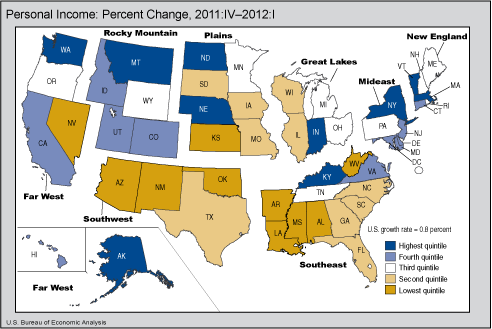News Release
State Quarterly Personal Income, 1st quarter 2011-1st quarter 2012
WASHINGTON DC, June 27, 2012 - State personal income growth accelerated to 0.8 percent in the first quarter of 2012, from 0.4 percent in the fourth quarter of 2011, according to estimates released today by the U.S. Bureau of Economic Analysis. Personal income rose in 47 of the 50 states, fell in Kansas and Mississippi, and was unchanged in Oklahoma. The percent change across states ranged from 2.3 percent in North Dakota to –0.3 percent in Mississippi. Inflation, as measured by the national price index for personal consumption expenditures, increased to 0.6 percent in the first quarter of 2012 from 0.3 percent in the fourth quarter of 2011.
Earnings by industry. Overall, earnings grew 0.8 percent in the first-quarter of 2012, after growing 0.5 percent in the fourth quarter. Earnings increased in 16 of the 24 industries for which BEA prepares quarterly estimates, with the largest percentage increases in the accommodations industry (which grew 2.5 percent, up from 1.2 percent in the previous quarter) and the construction industry (which grew 2.1 percent, up from 1.0 percent). The largest contributions to earnings growth were in health care (which increased $17.3 billion in the first quarter of 2012, up from a $6.8 billion increase in the fourth quarter) and professional services (which increased $16.5 billion, up from $7.1 billion).
In Nevada, the 1.4 percent earnings growth in the accommodations industry, the largest industry in the state, accounted for more than half of all earnings growth in the first quarter of 2012. (Accommodations earnings had fallen 0.5 percent in the fourth quarter in Nevada.)
In Texas, Iowa, Utah, Nebraska, West Virginia, and North Dakota construction earnings grew 4.0 percent or more in the first quarter of 2012, substantially above the national average. Construction earnings have grown continuously but slowly for five consecutive quarters nationally.
First-quarter earnings declined in 8 industries with the largest percentage decline, 6.4 percent, and largest dollar decline, $10.4 billion, in the real estate industry (real estate earnings fell 0.2 percent or $0.4 billion in the fourth quarter). Earnings have also declined for two consecutive quarters in the information industry and for three consecutive quarters in the utilities industry.
The decline in real estate earnings occurred in all states, the decline in information earnings occurred in all states except Washington and North Dakota, and the decline in utilities earnings occurred in 43 states.
Revisions. Estimates for 2011:I to 2011:IV have been revised. All of the regional statistics underlying this news release along with mapping and charting software are available at /regional/.
NOTE.— Quarter-to-quarter percent changes are calculated from unrounded data and are not annualized. Quarterly estimates are expressed at seasonally adjusted annual rates, unless otherwise specified. Quarter-to-quarter dollar changes are differences between published estimates.
Personal income is the income received by all persons from all sources. Personal income is the sum of net earnings by place of residence, property income, and personal current transfer receipts. Property income is rental income of persons, personal dividend income, and personal interest income. Net earnings is earnings by place of work (the sum of wage and salary disbursements, supplements to wages and salaries, and proprietors income) less contributions for government social insurance, plus an adjustment to convert earnings by place of work to a place-of-residence basis. Personal income is measured before the deduction of personal income taxes and other personal taxes and is reported in current dollars (no adjustment is made for price changes).
The estimate of personal income in the United States is derived as the sum of the state estimates and the estimate for the District of Columbia; it differs from the estimate of personal income in the national income and product accounts (NIPAs) because of differences in coverage, in the methodologies used to prepare the estimates, and in the timing of the availability of source data.
BEA groups all 50 states and the District of Columbia into eight distinct regions for purposes of data collecting and analyses: New England (Connecticut, Maine, Massachusetts, New Hampshire, Rhode Island, and Vermont); Mideast (Delaware, District of Columbia, Maryland, New Jersey, New York, and Pennsylvania); Great Lakes (Illinois, Indiana, Michigan, Ohio, and Wisconsin); Plains (Iowa, Kansas, Minnesota, Missouri, Nebraska, North Dakota, and South Dakota); Southeast (Alabama, Arkansas, Florida, Georgia, Kentucky, Louisiana, Mississippi, North Carolina, South Carolina, Tennessee, Virginia, and West Virginia); Southwest (Arizona, New Mexico, Oklahoma, and Texas); Rocky Mountain (Colorado, Idaho, Montana, Utah, and Wyoming); and Far West (Alaska, California, Hawaii, Nevada, Oregon, and Washington).
State personal income statistics provide a framework for analyzing current economic conditions in each state and can serve as a basis for decision making. For example:
- Federal government agencies use the statistics as a basis for allocating funds and determining matching grants to states. The statistics are also used in forecasting models to project energy and water use.
- State governments use the statistics to project tax revenues and the need for public services.
- Academic regional economists use the statistics for applied research.
- Businesses, trade associations, and labor organizations use the statistics for market research.
BEA's national, international, regional, and industry estimates; the Survey of Current Business; and BEA news releases are available without charge on BEA's Web site at www.bea.gov. By visiting the site, you can also subscribe to receive free e-mail summaries of BEA releases and announcements.
****
Next state personal income release – September 25, 2012, at 8:30 A.M. for state personal income, second quarter 2012.
